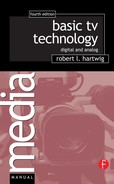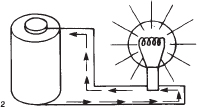All complete circuits are loops of flowing electrons.
Basic Circuits
Direct Current (DC)
A flashlight battery has the ability to provide a flow of electrons but accomplishes nothing sitting on the shelf, since it is only stored energy. Only when the positive terminal of the battery is attached to one end of a light bulb and the other end of the light bulb is attached to the negative terminal of the battery do we have a completed circuit, and the light bulb emits light. In this circuit all of the electrons continue to flow in the same direction. This is called direct current (DC). Of course, if there's only one wire between the light bulb and the battery, or if there's an open switch, the circuit is incomplete. The electrons have to flow through a complete loop in order to make the bulb light.
Such is the case with all electrical circuits. There must be a complete loop providing both a place for electrons to come from and a place for them to go. This is why the plugs to all your appliances at home have two prongs. (Note: Some plugs have three prongs. The third is a safety ground prong.) Most electrical devices will also have a switch somewhere in the circuit to allow you to interrupt the flow of electrons.
Alternating Current (AC)
The preceding example explained a simple DC circuit. Most circuits used in video equipment use direct current. However, there is another type of current that you will commonly encounter called alternating current (AC). With AC the flow of electrons changes direction constantly. The current flows from negative to positive, then from positive to negative, and so on. AC is much more efficient for transmission through wires over long distances. That's one of the reasons that it is used for household electricity. Some household appliances work better on AC (e.g., your clothes washer), and others work better on DC (e.g., the internal circuits of your TV), so the ability to easily change AC into DC is another good reason we use AC power for our main electricity supply.
2. Simple circuit.
3. Simple circuit with switch.
4. Alternating current.




